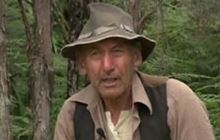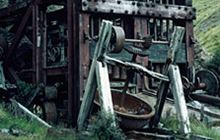Waiuta area
Located in the West Coast region
|
Introduction
Explore one of the West Coast's best known ghost towns. Waiuta was once a bustling mining settlement, producing nearly 750,000 ounces of gold from 1.5 million tons of quartz.
Tohu Whenua are the places that have shaped Aotearoa New Zealand. Located in stunning landscapes and rich with stories, they offer some of our best heritage experiences.
Find things to do and places to stay Waiuta area
Prohibition Mine and Ball Mill
From the old Waiuta town site, "Pro Road" winds up to the top of the country's deepest mineshaft (879 metres) and foundations of the ball mill where quartz was ground to extract gold. There are fine views from a 580 metre altitude. Part of the return journey can be made via the miners' short-cut track, which leaves the road just below the mine.
Waiuta is halfway between Reefton and Greymouth. It is signposted from SH7, 21 km south of Reefton. Turn onto Waiuta Rd, then right onto Blackwater Rd, which becomes Pearce Rd.
Waiuta goldmine
On 9 November 1905 a prospecting party found the “Birthday Reef” of gold, on King Edward VII’s birthday. They sold their claim to a speculator, P.N. Kingswell for £2,000. Kingswell proved the reef and sold the site to the Consolidated Goldfield Ltd for £30,000.
The first mineshaft was fully operational by 1908. Known as the Blackwater shaft, it reached a depth of 563 m. The mine was extended in 1926 with the acquisition of the adjacent Blackwater North claim, which was renamed the Prohibition. The Prohibition shaft took over in 1938 and reached 879 m deep.
Town life
Waiuta township grew along with the mine, and by the 1930s the population had grown to around 600 people. Due to its isolated location, the town became largely self sufficient in terms of facilities, shops and social life. It became well known on the West Coast for its many sports teams and regular balls.
Gold mining
Miners drilled and blasted gold-bearing quartz rock out of the underground reef. The rock was then trucked through tunnels to the shaft where it was winched to the surface for processing.
The mine produced nearly 750,000 ounces of gold from 1.5 million tons of quartz.
Gold processing
From 1908 to 1937 gold was processed at the Snowy Battery. The gold was pounded out of the rock using the water powered ‘battery’ of iron stamps. The battery was superseded in 1938 by a modern ball mill on Prohibition Hill. Here iron balls in revolving steel drums crushed the quartz rock.
Four separate electric power generating plants provided electricity over the life of the mine, supplying the township as well as the processing plants.
The end
In 1951 the Blackwater shaft collapsed, blocking the ventilation system. As it was uneconomical to repair the shaft, the mine closed leaving the residents unemployed and with no choice but to abandon the town.
DOC’s work
- DOC maintains the Blackwater chimney and winding engine foundation remains along with many other relics, including the Snowy River battery, Prohibition ball mill, and powerhouse sites.
- DOC maintains various road and walking track networks throughout the 63 ha site.
- Eight buildings remain, two are privately owned: the Police Cottage by the White family, and Gills Cottage by the Friends of Waiuta Society Inc.
- DOC operates the 30 bunk Waiuta Lodge as overnight accommodation.
- There is a volunteer assisted programme of weed eradication, mainly carried out by the Friends of Waiuta. These volunteers and many others assist with historic site clearance and maintenance work.
Contacts
| Paparoa National Park Visitor Centre | |
|---|---|
| Phone | +64 3 731 1895 |
| paparoavc@doc.govt.nz | |
| Address | 4294 Coast Road Punakaiki RD 1 Runanga 7873 |
| Hours | Visitor centre hours and services |


